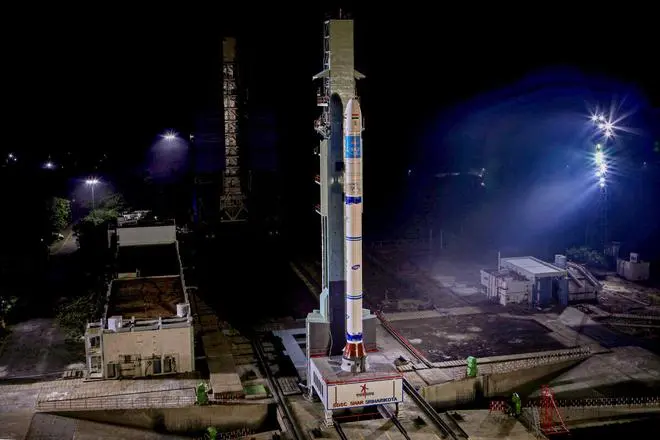The second developmental flight of the Small Satellite Launch Vehicle (SSLV), SSLV-D2 was successfully launched on February 10, 2023, at 9:18 am from the first launch pad at Satish Dhawan Space Centre (SDSC) SHAR, Sriharikota.
It injected EOS-07, Janus-1, and AzaadiSAT-2 satellites into a 450 km circular orbit, in its 15-minute flight.
Today’s launch was significant after the first developmental flight of the SSLV from SDSC on August 7, 2022, failed due to vibration disturbance for a short duration on the equipment bay deck during the second stage separation.
The main objectives of Friday’s mission were the demonstration of the designed payload capability of SSLV in low earth orbit and the injection of the EOS-07 satellite, and two passenger satellites Janus-1 and AzaadiSAT-2 into a 450 km circular orbit.
“SSLV-D2/EOS-07 Mission is accomplished successfully. SSLV-D2 placed EOS-07, Janus-1, and AzaadiSAT-2 into their intended orbits,” ISRO tweeted.
SSLV caters to the launch of up to 500 kg satellites to low earth orbits on a ‘launch-on-demand’ basis. It provides low-cost access to space, offers low turn-around time and flexibility in accommodating multiple satellites, and demands minimal launch infrastructure.
It is configured with three solid propulsion stages and a velocity terminal module. It is a 34 m tall, 2 m diameter vehicle having a lift-off mass of 120 tonne.
ISRO’s Small Satellite Launch Vehicle (SSLV), SSLV-D2 containing EOS-07, Janus-1, and AzaadiSAT-2 satellites taking off from Sriharikota
The EOS-07 is a 156.3 kg satellite designed, developed, and realised by ISRO. New experiments include mm-Wave Humidity Sounder and Spectrum Monitoring Payload.
Janus-1, a 10.2 kg satellite, belongs to ANTARIS, US. Janus-1 is a technology demonstrator, smart satellite mission, based on the Antaris software platform.

ISRO’s Small Satellite Launch Vehicle SSLV-D2 carrying EOS-07, Janus-1 and AzaadiSAT-2 satellites sits on a launch pad ahead of its launch, at the Satish Dhawan Space Centre in Sriharikota, Thursday, February 9, 2023. (PTI Photo)
The 8.7 kg satellite AzaadiSAT-2 is a combined effort of about 750 girl students across India guided by Space Kidz India, Chennai. It aims to demonstrate LoRa and amateur radio communication satellites, measure radiation levels in space, and demonstrate expanding satellite structure, the release said.
As the last satellite was separated from the rocket, there was jubilation and emotions in the control room, and hundreds of school children were rejoicing the spectacular view of the take-off from the viewing gallery a couple of km away.
Congratulatory messages
“Congratulations to the space community in India. We have a new launch vehicle (SSLV). In its second attempt today, the SSLV-D2 has placed the EOS-07 satellites in its intended orbit very accurately, along with two more satellites — Janus-1 and Azaadi SAT-2,” said S Somanath, Chairman, ISRO. “The year 2023, this was the inaugural launch and I think, and will set the tune for the rest of the activities that are going to happen,” he said from the control room after the launch.
“SSLV had its maiden flight (SSLV-D1), and we had a narrow miss of playing the satellites in the orbit because of a shortfall in velocity. We have analysed the problems faced in D1; identified the corrective actions; implemented at a very fast pace; qualified all of those new systems; went through a large amount of simulations and studies to ensure that the vehicle will become successful this time, he said. I am happy to share that the rally intended model vehicle has been executed in reality in flight,” he added.
The orbit achieved by the vehicle today using very novel, cost-effective guidance and innovative navigation systems is exceedingly good, the Chairman said. “We were targeting to put it in a 450 km orbit. We have close apogee and perigee and the inclination is very small error only. This shows that the new model of the vehicle navigation system incorporated in SSLV is doing very well.”
Mission Director SS Vinodh said, “In the shortest time of five months, we had to realise five new hardware; a new separation system and in addition to that, we had to make modifications to the navigation and the guidance scheme, and also carry out a lot of testing to make the system robust.”










Comments
Comments have to be in English, and in full sentences. They cannot be abusive or personal. Please abide by our community guidelines for posting your comments.
We have migrated to a new commenting platform. If you are already a registered user of TheHindu Businessline and logged in, you may continue to engage with our articles. If you do not have an account please register and login to post comments. Users can access their older comments by logging into their accounts on Vuukle.